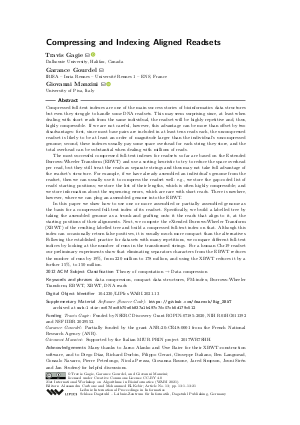@InProceedings{gagie_et_al:LIPIcs.WABI.2021.13,
author = {Gagie, Travis and Gourdel, Garance and Manzini, Giovanni},
title = {{Compressing and Indexing Aligned Readsets}},
booktitle = {21st International Workshop on Algorithms in Bioinformatics (WABI 2021)},
pages = {13:1--13:21},
series = {Leibniz International Proceedings in Informatics (LIPIcs)},
ISBN = {978-3-95977-200-6},
ISSN = {1868-8969},
year = {2021},
volume = {201},
editor = {Carbone, Alessandra and El-Kebir, Mohammed},
publisher = {Schloss Dagstuhl -- Leibniz-Zentrum f{\"u}r Informatik},
address = {Dagstuhl, Germany},
URL = {https://drops.dagstuhl.de/entities/document/10.4230/LIPIcs.WABI.2021.13},
URN = {urn:nbn:de:0030-drops-143660},
doi = {10.4230/LIPIcs.WABI.2021.13},
annote = {Keywords: data compression, compact data structures, FM-index, Burrows-Wheeler Transform, EBWT, XBWT, DNA reads}
}

 Creative Commons Attribution 4.0 International license
Creative Commons Attribution 4.0 International license










































